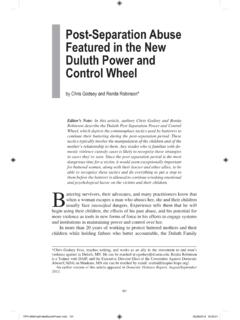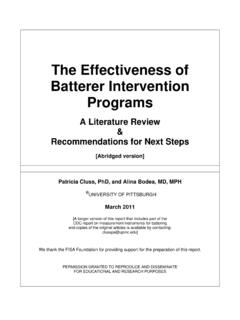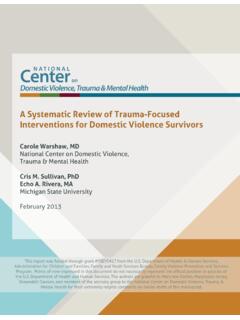Transcription of Minimum Standards for Batterer Intervention Programs
1 LCADV RESEARCH CONSORTIUM A PROJECT OF THE LOUISIANA COALITION AGAINST domestic VIOLENCE Minimum Standards for Batterer Intervention Programs Victor L. Bissonnette, Eric Carlson, , Barbara P. Davidson, Pat Davis, , Jean H. Hollenshead, Shannon W. Kilpack, Michelle Masse, Patsy Taylor September 1997 Revised February 2015 PAGE 2 LCADV RESEARCH CONSORTIUM Louisiana Coalition Against domestic Violence Post Office Box 77308 Baton Rouge, LA 70879-7308 Phone: 225/752 1296 Current Members 1998 Merni Carter, , Coordinator Louisiana Coalition Against domestic Violence Baton Rouge Jean H. Hollenshead, Louisiana State University Shreveport CHAIRPERSON Pamela Jenkins, University of New Orleans Melissa Kater 1" Judicial District Attourney's Victim Assistance Program Shreveport PARTICIPANTS Victor Bissonnette, Southeastern Louisiana University Hammond Mary Capps, Nicholls State University Thibodaux Eric Carlson, , Bossier Diagnostic and Counseling Center Bossier City Angela Clark Formerly Battered Women's Task Force Baton Rouge Tracy Dahmer, Tangipahoa Parish Sheriffs Office Hammond Barbara Davidson, Battered Women's Program Baton Rouge Pat Davis, , Office of Public Health Louisiana Dept.
2 Of Health and Hospitals New Orleans New Orleans Clayton Latimer Department of Social Services New Orleans Catherine Lemieux, Louisiana State University Baton Rouge Bonnie Lewis, Southeastern Louisiana University Hammond Michelle Masse , Louisiana State University Baton Rouge Ann Polak Calcasieu Women's Shelter Lake Charles Kathy Sambola, , Southeastern Louisiana University Hammond Patsy Taylor Louisiana Training Consortium Ponchatoula Christopher Velardo, , domestic Violence Offender Program Baton RougePAGE 3 Purpose of this Document The development of Minimum Standards for Batterer Intervention Programs was undertaken by the LCADV Research Consortium in order to define and describe the recommended program structure, format, content and techniques used by Programs that target perpetrators of domestic violence.
3 These Standards are intended for use by practitioners when designing new Programs or adapting existing Programs , and as a guide for use by court systems when deciding which Intervention Programs are appropriate for court referral. As Intervention with batterers is an evolving and specialized field of practice, the Consortium's work included as the basis for this document an extensive survey of current research, examination of existing Standards and proven models used in other states, and distillation of the professional expertise of the Consortium members. History of this Document This document was developed by the LCADV Research Consortium, a project of the Louisiana Coalition Against domestic Violence.
4 The consortium was initiated in January 1995, in order to bring together advocates, clinicians, and scholars to identify, evaluate, and publicize responsible Intervention methods in the field of domestic violence. The Louisiana Coalition Against domestic Violence is a network of battered women's Programs , other organizations, and individuals who share the common goal of ending violence against women and their children in Louisiana. The Coalition arose out of the desire of those working with battered women and their children to meet on a regular basis to share ideas and information, obtain training relevant to their work, jointly study and respond to proposed government policies and procedures, and enhance their individual efforts to effect social change.
5 The Standards outlined in this document have been reviewed and approved by the member Programs of the Louisiana Coalition Against domestic Violence. In the 2014 legislative session, in response to problems noted in the field, advocates requested changes to the state law governing domestic abuse Intervention Programs . In the fall of 2014, LCADV began assembling a small workgroup to craft opportunities to educate communities about these changes and better engage domestic abuse Intervention Programs with the coalition. In January and February of 2015, this workgroup completed minor updates to the Standards , which brought them better in compliance with new state law. Workgroup Members: Robert Hanser, Sami Riley 4th Judicial District Batterer Intervention Program Chez Hope Monroe, LA Franklin, LA Beth Meeks, Mariah Stidham Wineski Louisiana Coalition Against domestic Violence Louisiana Coalition Against domestic Violence Baton Rouge, LA Baton Rouge, LA Ralph Peters, Family Violence Intervention Program Lafayette, LA PAGE 4 Guiding Principles for Batterer Intervention Programs The primary purpose of any Batterer Intervention program is to stop domestic violence.
6 The safety of individual victims and potential victims of domestic violence should supersede all other Intervention program policies. All Batterer Intervention Programs must, through all phases of development, implementation and evaluation: hold batterers accountable for their violent and controlling behavior, disallow collusion and victim blaming by batterers and others, and teach new skills that will facilitate changes in their behavior. The Intervention methods should not focus on the relationship or the actions of the battered partner, but maintain a focus on the Batterer 's violent behavior and the safety of the battered partner. continually assess the lethality of all program participants, and take appropriate action to protect partners, minor children, and others from known dangers posed by the program participants.
7 Work collaboratively with battered women's service providers to assure that battered partners are provided access to advocacy and other assistance while the abusers are participating in the Intervention program. Batterer Intervention services should complement, not compete with, battered women's services for resources such as staff or funding. Batterer Intervention Programs should be part of a coordinated community response to domestic violence. report compliance and noncompliance to the courts or other referral sources. challenge myths about domestic violence and promote "zero tolerance" of violent behavior. Batterer Intervention and The Court System Intervention service providers should maintain familiarity with the federal, state, and local laws on domestic violence, and with the operation of the criminal justice system.
8 In particular, Intervention service providers should be familiar with laws pertaining to crimes against persons, with their duty to warn individuals who may be in danger, and with the legal mandate to report child abuse and neglect, as well as abuse of the elderly. The Exchange of Information Each Intervention program should establish and maintain an ongoing exchange of information with the court system ( , attorneys, judges, and probation/parole officers), with the batterers who are applicants or participants in the Intervention program, and with the battered partners or other potential victims of these batterers. The activities involved in this information exchange will vary depending on whether or not the Batterer Intervention program is providing services that are court-mandated.
9 PAGE 5 We strongly recommend that each Intervention program establish some formal agreement ( , a memorandum of understanding) with the court system that specifies the exchange of information. The following list outlines some important items that should be covered in such an agreement: the method of exchange of information between the Intervention program and the court, including: how the Intervention program is to obtain pertinent court records, ( , protection orders, arrest records, bail conditions, and probation/parole conditions), as well as prior treatment records; and how any further incidents of violence or violations of any court orders will be documented and reported to the court; and how the Intervention program will comply with court requirements to provide participant evaluations to the court or designated agency.
10 These could include attendance, participation, progress, and recommendations for further Intervention . the Intervention program's authority over intake and screening, case management, duration of services, and the parameters of confidentiality. the acceptance criteria of the Intervention program. the fees or financial costs of the Intervention program. the consequences for a participant who violates the Intervention program's policies. the consequences for a participant who is discharged before the completion of the program, and the role of the program's staff in hearings on the participant's failure to comply with the Intervention mandate. the responsibility of the Intervention program to inform law enforcement and any appropriate agency, as well as the battered partner, of any known risk of violent behavior posed by the program participant that may result in serious bodily injury or death to the battered partner or any other person.









